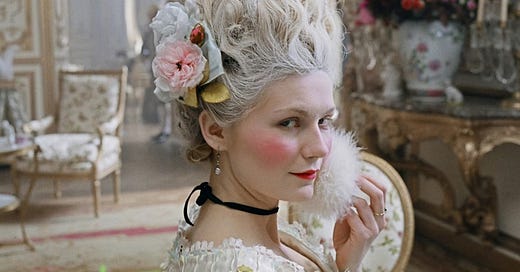OCTOBER 2006—Seven months pregnant, wearing a black knee-length maternity dress, substituting ballet flats for her usual flip-flops in a Los Angeles hotel, Sofia Coppola is unapologetic about the style of her third feature, Marie Antoinette, based on a biography by Antonia Fraser.
While some reviewers have rehearsed their chops as scholars of French history since the movie’s Cannes debut, the thirty-five-year-old Coppola confesses she applied a “very girlie, feminine sensibility” toward a “silk and cake” world. Fittingly, when jokingly asked who made her dress, she shrugs and turns the label out for display. In an Observer profile, Sean O’Hagan described the affect as playing “a day-dreamy, slightly disconnected but immaculately stylish waif who seems all at sea in a world of extraordinary privilege.”
In similar fashion, Jersey girl Kirsten Dunst plays the Austrian fourteen-year-old who was stripped at the French border of nationality, pug and clothing, to become Marie Antoinette, and wife in an arranged marriage to Dauphin Louis, eventually to be King Louis XVI (a bulked-up Jason Schwartzman). Versailles ensues: Marie Antoinette was given extensive access to the royal grounds (only on Mondays, when it’s closed to tourists). When the marriage remains unconsummated for seven years, Marie becomes increasingly indiscreet, more of a party girl, drenched in the decadence of gowns, wigs, shoes, champagne, and all manner of cookies and cake.
Coppola is incredibly self-aware: as that child of privilege American movie royalty with many friends in fashion, the film is as “personal” as The Virgin Suicides and Lost in Translation. There is a moment when a torch-bearing mob has surrounded Versailles and Marie tentatively approaches, emerging from darkness to watch them wide-eyed. There is a hush. She curtsies quietly, deeply. Then the crowd begins to boo again. It’s hard not to be reminded of the death of Coppola’s character as Michael Corleone’s daughter at the opera that ends the ill-fated Godfather III. And for me, there is a magnificent shot at the very end of the picture that counts as a true, very knowing coup de théâtre. (Design has its density, too: some of the picture’s palette is drawn from pastel macarons Coppola found at Paris’ Ladurée bakery.)
The soundtrack bursts with pop anachronism. Who, dancing away at clubs in the early 1980s, would imagine the first big-budget musical to use the melodies that era would be this one? Opening to the fierce chords of Gang of Four’s “Natural’s Not In It” (a bit of a hint?), and including songs by The Cure, Marie Antoinette also boasts a masked ball scored to Siouxsie and the Banshees’ “Hong Kong Garden.”
“The New Romantic music I listened to when I was a kid had this playfulness in the way bands like Bow Wow Wow and Adam Ant referenced the eighteenth century. It was a film about teenagers and that mischievous, vital, youthful period. We had a little bit of a punk attitude to say that we were going to do history from this young girl’s point of view. I wanted to have a real contrast between the world of the adults in court and the kids.”
Coppola is a contrarian, after a fashion. “When I read Antonia Fraser’s biography, what was interesting to me was to read about the real human behind all the myths and the icon that we all heard about, the frivolous, evil French Queen. So I wanted to present a portrait of a real person, based on the research and the letters, and do more of an intimate portrait of this woman. I never set out to make an historical epic.” (Fraser told Coppola that her husband, Harold Pinter, "enjoyed it enormously.")
Of this brightly colored world, she says, “I mean, it’s not a documentary or a history lesson, I wanted it to be impressionistic and as close to what it might have felt like to be there at that time. When I saw Amadeus and they were just speaking in their regular accents, they felt like real people to me, as opposed to someone living in some other era that I couldn’t relate to.” (The cast of Marie Antoinette, including Rip Torn, Steve Coogan and Marianne Faithful, plays their own accent except for a couple lines from a little girl.)
“For me it was a challenge to try to make a period film because it was difficult for me: ‘How do you make a film in that period but also do it in my style and make it personal to me?’ The biggest challenge to me was to work on that scale and still stay focused, not get lost in all that. To me, it was important to keep the focus on the main characters, and the acting and the emotion, and not just get carried away with all the grandeur around.”




